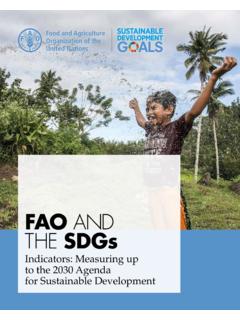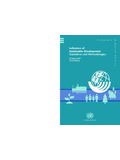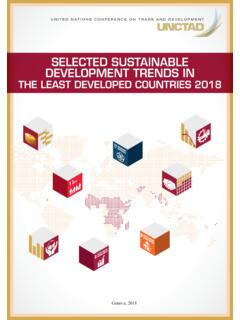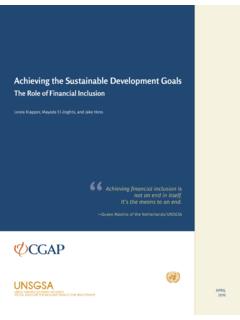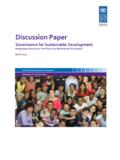Transcription of OECD
1 OECD. KEY ENVIRONMENTAL. INDICATORS. OECD Environment Directorate Paris, France - OECD KEY ENVIRONMENTAL. INDICATORS. 2008. ORGANISATION FOR ECONOMIC development AND CO-OPERATION. - ORGANISATION FOR ECONOMIC CO-OPERATION. AND development . The OECD is a unique forum where the governments of 30 democracies work together to address the economic, social and environmental challenges of globalisation. The OECD is also at the forefront of efforts to understand and to help governments respond to new developments and concerns, such as corporate governance, the information economy and the challenges of an ageing population. The Organisation provides a setting where governments can compare policy experiences, seek answers to common problems, identify good practice and work to co-ordinate domestic and international policies. The OECD member countries are: Australia, Austria, Belgium, Canada, the Czech Republic, Denmark, Finland, France, Germany, Greece, Hungary, Iceland, Ireland, Italy, Japan, Korea, Luxembourg, Mexico, the Netherlands, New Zealand, Norway, Poland, Portugal, the Slovak Republic, Spain, Sweden, Switzerland, Turkey, the United Kingdom and the United States.
2 The Commission of the European Communities takes part in the work of the OECD. This work is published on the responsibility of the Secretary-General of the OECD. The opinions expressed and arguments employed herein do not necessarily reflect the official views of the Organisation or of the governments of its member countries. OECD 2008. No reproduction, copy, transmission or translation of this publication may be made without written permission. Applications should be sent to OECD. Publishing: or by fax (33 1) 45 24 99 30. Permission to photocopy a portion of this work should be addressed to the Centre fran ais d'exploitation du droit de copie, 20, rue des Grands-Augustins, 75006 Paris, France or (for US only) to Copyright Clearance Center (CCC), 222 Rosewood Drive, Danvers, MA 01923, USA, fax 1 978 646 8600, FOREWORD. Environmental indicators are essential tools for tracking environmental progress, supporting policy evaluation and informing the public.
3 Since the early 1990s, such indicators have gained in importance in many countries and in international fora. As part of their commitment to transparency and to better information of the public, OECD countries increasingly use a reduced number of indicators, so-called key indicators , selected from larger sets to report on major environmental issues. The OECD pioneered the development of international environmental indicators and has long supported its member countries' efforts in this field. Its work has led to several sets of environmental indicators, each responding to a specific purpose. The present report is one of the products of the OECD programme on environmental indicators. It includes key environmental indicators endorsed by OECD Environment Ministers in May 2001 for public information and communication by OECD. These indicators give a broad overview of environmental issues in OECD countries and are updated every year.
4 This 2008 version was presented to OECD Environment Ministers (Paris, 28-29 April 2008). This report was prepared by the OECD Secretariat, but its successful completion depended on the work and support of the OECD Working Group on Environmental Information and Outlooks. It is published on the responsibility of the OECD Secretary-General. Lorents G. Lorentsen Director, OECD Environment Directorate -3- The indicators in this report build on data published in OECD Environmental Data - Compendium. They were updated or revised on the basis of data from other OECD and international sources and on the basis of comments from national Delegates available to the OECD Secretariat at mid- March 2008. These data come from the OECD SIREN* database, which is regularly updated with information provided by Member countries' authorities (through biennial data collection using the OECD/Eurostat questionnaire on the state of the environment), from internal OECD sources and from other international sources.
5 The data are harmonised through the work of the OECD Working Group on Environmental Information and Outlooks (WGEIO) and benefit from continued data quality efforts in OECD member countries, the OECD itself and other international organisations. In many countries, systematic collection of environmental data has a short history; sources are typically spread across a range of agencies and levels of government, and information is often collected for other purposes. When reading this report, one should keep in mind that definitions and measurement methods vary among countries, and that inter-country comparisons require careful interpretation. One should also note that indicators presented in this report refer to the national level and may conceal major sub-national differences. OECD and World projections are based on various international Outlooks (OECD, OECD-IEA, FAO-UNECE, FAO). * System of Information on Resources and the Environment -4- OECD KEY ENVIRONMENTAL INDICATORS.
6 TABLE OF CONTENTS. 7. KEY INDICATORS .. 11. 1. CLIMATE CHANGE CO2 and greenhouse gas emission intensities .. 12. 2. OZONE LAYER - ozone depleting substances .. 14. 3. AIR QUALITY SOx and NOx emission 16. 4. WASTE GENERATION municipal waste generation intensities .. 18. 5. FRESHWATER QUALITY waste water treatment connection rates .. 20. 6. FRESHWATER RESOURCES intensity of use of water resources .. 22. 7. FOREST RESOURCES intensity of use of forest 24. 8. FISH RESOURCES intensity of use of fish 26. 9. ENERGY RESOURCES intensity of energy use .. 28. 10. BIODIVERSITY threatened species .. 30. ANNEX: OECD framework for environmental indicators .. 33. References and bibliography .. 36. -5- INTRODUCTION. -7- KEY ENVIRONMENTAL INDICATORS. BACKGROUND The OECD, with the support of its Member countries, has long been a pioneer in the field of environmental indicators. It has developed and published the first international sets of environmental indicators and uses them regularly in its country environmental performance reviews and other policy analysis work.
7 Central to the OECD work are core environmental indicators included in the OECD Core Set, to measure environmental progress, complemented with several sets of sectoral environmental indicators to help integrate environmental concerns in sectoral policies. Indicators are further derived from environmental accounting and work is done on indicators to measure the decoupling of environmental pressure from economic growth. During the 1990s, environmental indicators gained significant importance and are now widely used in OECD countries. They are used in reporting, planning, clarifying policy objectives and priorities, budgeting, and assessing performance. WHY KEY Many OECD countries are also increasingly interested in using a reduced number of INDICATORS? indicators selected from existing larger sets, to inform civil society and to support wider communication with the public. To support such initiatives, the OECD identified in 2001 a shortlist of environmental indicators building on previous work and on experience gained in using environmental indicators in its policy work.
8 SELECTION These key indicators have been selected from the core indicators included in the OECD. CRITERIA Core Set of environmental indicators and are closely related to other environmental indicators sets developed and used by the OECD. Their selection took into account: their policy relevance with respect to major challenges for the first decade of the 21st century, including pollution issues and issues related to natural resources and assets; their analytical soundness; and their measurability. OECD set of key environmental indicators POLLUTION ISSUES Available indicators* Medium term indicators**. Climate change 1. CO2 emission intensities Index of greenhouse gas emissions Index of greenhouse gas emissions Ozone layer 2. Indices of apparent consumption of ozone Same, plus aggregation into one index of depleting substances (ODS) apparent consumption of ODS. Air quality 3. SOx and NOx emission intensities Population exposure to air pollution Waste generation 4.
9 Municipal waste generation intensities Total waste generation intensities, Indicators derived from material flow accounting Freshwater quality 5. Waste water treatment connection rates Pollution loads to water bodies NATURAL RESOURCES & ASSETS. Freshwater resources 6. Intensity of use of water resources Same plus sub-national breakdown Forest resources 7. Intensity of use of forest resources Same Fish resources 8. Intensity of use of fish resources Same plus closer link to available resources Energy resources 9. Intensity of energy use Energy efficiency index Biodiversity 10. Threatened species Species and habitat or ecosystem diversity Area of key ecosystems _____ _____. * indicators for which data are available for a majority ** indicators that require further specification and of OECD countries and that are presented in this development (availability of basic data sets, underlying report concepts and definitions).
10 Key Environmental Indicators -8- OECD 2008. A DYNAMIC The list of indicators hence is neither final, nor exhaustive; it will evolve as knowledge and PROCESS data availability improve. Ultimately, the list is expected to also include key indicators for issues such as toxic contamination, land and soil resources, and urban environmental quality. INTERPRETATION It has to be noted that the indicators correspond to varying degrees of policy relevance and policy priority for different countries. Like other indicators they have to be interpreted in context and be complemented with country specific information to acquire their full meaning. THIS PUBLICATION. CONTENT AND The present report is a product of the OECD work programme on environmental indicators. PURPOSE It presents key environmental indicators endorsed by OECD Environment Ministers in 2001. as a tool for use by OECD. These indicators give a broad overview of environmental issues of common concern in OECD countries, and inform policy makers and the public about progress made and to be made.










